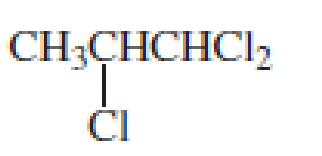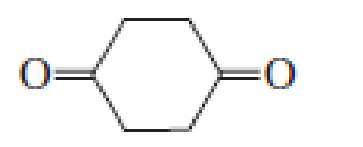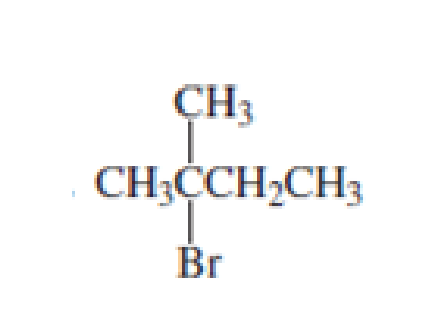
Essential Organic Chemistry Study Guide & Solution Manual, Books a la Carte Edition
3rd Edition
ISBN: 9780134255644
Author: Bruice, Paula Yurkanis
Publisher: PEARSON
expand_more
expand_more
format_list_bulleted
Concept explainers
Textbook Question
Chapter 10.28, Problem 46P
Describe the 1H NMR spectrum you would expect for each of the following compounds, Indicating the relative positions of the signals:
- a. BrCH2CH2CH2CH2Br
- b. CH3OCH2CH2CH2Br
- c. CH3CH2OCH2CH3
- d. CH3CH2OCH2Cl

- e. CH3OCH2CH2CH2OCH3


Expert Solution & Answer
Want to see the full answer?
Check out a sample textbook solution
Students have asked these similar questions
Please explain thoroughly and provide steps to draw.
As you can see in the picture, the instrument uses a Xe source. Given that the instrument is capable of measuring from 200-800nm, if Xe was not used, what other source(s) could be used? Refer to figure 7-3.
How many monochrometers does this instrument have? Why?
Trace the light as it goes from the Xenon lamp all the way to the circle just slightly to the right and a little bit down from S4. What do you think that circle is? In class we talked about many types of these, which kind do you think this one is for a fluorimeter? Why? Explain.
What is/are some strategy(ies) that this instrument has for dealing with noise that you see present in the optics diagram?
Why does a fluorescence cuvette have to be clear on four sides?
Provide steps and thoroughly solve.
Chapter 10 Solutions
Essential Organic Chemistry Study Guide & Solution Manual, Books a la Carte Edition
Ch. 10.1 - Prob. 1PCh. 10.2 - What would distinguish the mass spectrum of...Ch. 10.2 - Prob. 3PCh. 10.3 - Prob. 5PCh. 10.3 - Suggest possible molecular formulas for a compound...Ch. 10.3 - Prob. 7PCh. 10.4 - Prob. 8PCh. 10.4 - Prob. 9PCh. 10.5 - Prob. 10PCh. 10.5 - Prob. 11P
Ch. 10.6 - Identify the ketone responsible for the mass...Ch. 10.6 - Prob. 13PCh. 10.8 - Prob. 14PCh. 10.8 - Prob. 15PCh. 10.12 - Which will occur at a larger wavenumber: a. a C :...Ch. 10.13 - Which will occur at a larger wavenumber: a. the C...Ch. 10.13 - Prob. 18PCh. 10.13 - Prob. 19PCh. 10.13 - Which will show an O 8 H stretch at a larger...Ch. 10.14 - Prob. 21PCh. 10.14 - Prob. 22PCh. 10.15 - Prob. 23PCh. 10.15 - Prob. 24PCh. 10.17 - Prob. 25PCh. 10.18 - Prob. 26PCh. 10.18 - Prob. 27PCh. 10.19 - Prob. 28PCh. 10.19 - Prob. 29PCh. 10.22 - How many signals would you expect to see in the 1H...Ch. 10.22 - Prob. 31PCh. 10.22 - Prob. 32PCh. 10.23 - Where would you expect to find the 1H NMR signal...Ch. 10.24 - Prob. 34PCh. 10.25 - Prob. 35PCh. 10.25 - Prob. 36PCh. 10.25 - Prob. 37PCh. 10.26 - Prob. 38PCh. 10.26 - Which of the following compounds is responsible...Ch. 10.27 - Prob. 40PCh. 10.27 - Prob. 41PCh. 10.27 - The 1H NMR spectra of two carboxylic acids with...Ch. 10.28 - Prob. 43PCh. 10.28 - Prob. 44PCh. 10.28 - Prob. 45PCh. 10.28 - Describe the 1H NMR spectrum you would expect for...Ch. 10.28 - Identify the compound with molecular formula...Ch. 10.29 - Prob. 48PCh. 10.29 - Prob. 49PCh. 10.29 - Identify the compound with a molecular formula of...Ch. 10 - In the mass spectrum of the following compounds,...Ch. 10 - For each of the following pairs of compounds,...Ch. 10 - Draw the structure of a saturated hydrocarbon that...Ch. 10 - Prob. 54PCh. 10 - Prob. 55PCh. 10 - How could you use UV spectroscopy to distinguish...Ch. 10 - Prob. 57PCh. 10 - Predict the relative intensities of the molecular...Ch. 10 - Prob. 59PCh. 10 - List the following compounds in order from highest...Ch. 10 - How can 1H NMR be used to prove that the addition...Ch. 10 - There are four esters with molecular formula...Ch. 10 - Prob. 63PCh. 10 - Prob. 64PCh. 10 - Each of the IR spectra presented here is...Ch. 10 - Prob. 66PCh. 10 - Five compounds are shown for each of the following...Ch. 10 - Prob. 68PCh. 10 - Prob. 69PCh. 10 - Phenolphthalein is an acidbase indicator. In...Ch. 10 - Which one of the following five compounds produced...Ch. 10 - Prob. 72PCh. 10 - Prob. 73PCh. 10 - Prob. 74PCh. 10 - How could 1H NMR distinguish between the compounds...Ch. 10 - Prob. 76PCh. 10 - Prob. 77PCh. 10 - The 1H NMR spectra of three isomers with molecular...Ch. 10 - The 1H NMR spectra of three isomers with molecular...Ch. 10 - Identify the following compounds. (Relative...Ch. 10 - An alkyl halide reacts with an alkoxide ion to...Ch. 10 - Determine the structure of a compound with...
Knowledge Booster
Learn more about
Need a deep-dive on the concept behind this application? Look no further. Learn more about this topic, chemistry and related others by exploring similar questions and additional content below.Similar questions
- Nonearrow_forwardDevise a synthesis to prepare 4-tert-butyl-2-nitrotoluene from toluene. Complete the following reaction scheme. Part 1 of 4 Step 1 Step 2 A B Draw the structure for compound B, 4-tert-butyl-2-nitrotoluene. Click and drag to start drawing a structure. 'O Х ப:arrow_forwardWhat is N hybridized? sp3 or sp2? whyarrow_forward
- Date Unknown o Hydrated Salt Lab Sec. Name Trial I Trial 2 1. Mass of fired crucible and lid (g) 2. Mass of fired crucible, lid, and hydrated sah (g) 3. Instructor's approval of flame and apparatus 4. Mass of crucible, lid, and anhydrous salt Ist mass measurement (g) 2nd mass measurement (g) 3rd mass measurement (g). Desk No. Trial 3 48.833 46.808 213.692 51.507 9.359 46,615 50.296 48.211 45.351 50.142 48.146 45.1911 50.103 48.132 45.186 5. Final mass of crucible, lid, and anhydrous salt (g) 50.180 4.13 45.243 Calculations 1. Mass of hydrated salt (g) 2. Mass of anhydrous salt (g) 2.674 2.491 2.9239 1.3479 1.2959 1.5519 3. Mass of water lost (g) 1.32791969 1.322g 4. Percent by mass of volatile water in hydrated salt (%) 49.6% 48% 216.9% 5. Average percent HO in bydrated salt (%H,O) 5. Standard deviation of %H,O Relative standard deviation of %H,O in hydrated salt (RSD) how calculations on next page. 48.17% Data Analysis, B Data Analysis, C Data Analysis, D Experiment 5 89arrow_forwardConsidering the irregular electronic configurations we discussed for certain transitionmetals, think about the possibility of silicon (Si) having a [Ne]3s 2 3p 2 configuration vs.[Ne]3s 1 3p 3. Discuss the pros and cons of both configurations. Which one does Si actuallyadopt and why?arrow_forward(5 Pts) Currently, the last element in the periodic table is number 118, oganesson (Og). Channel your inner Dimitri Mendeleev and predict element 119’s electronic configuration, atomic mass, density, and either melting or boiling point. Justify your answers.arrow_forward
- Don't used hand raiting and don't used Ai solutionarrow_forwardShow work. don't give Ai generated solutionarrow_forward21. Zn Cl₂→ ZnCl2 22. ZnCO3 ZnO CO₂ 23. Mg + Sg MgS 24. Fe + Cl₂ FeCl3 25. Ag + S8 Ag₂S 26. K S8 K₂S 27. Al HCI AlCl3 H2 28. Mg H3PO4 Mg3(PO4)2 + H₂ 29. Cu + AgNO3 Cu(NO3)2 + Ag 30. Al + Pb(NO3)2 Pb + Al(NO3)3 31. Zn + Sn(NO3)4 Zn(NO3)2 Sn 32. Cl2 + All 3 AlCl3 _ 12 33. Br2 + Cul CuBr 12 34. KBr + Pb(NO3)2 KNO3 PbBr2 These next ones have an element shared between two different compounds. The Total amount in the Reactatnt still needs to equal the total amount in the product. 35.H₂O2 ← H₂O + 0₂ 36. C₂Ho CO2 + H₂O 37. Zn + HCI → ZnCl+ H₂ 38. NH3 + _HCl → NH.C 39. Mg(OH)2 + H3PO4 → H₂O+ Mg3(PO4)2 40. NHẠOH + FeCl3 NH4Cl + Fe(OH)3arrow_forward
- Don't used hand raiting and don't used Ai solutionarrow_forwardBalance the following equations Synthesis Ca 1. Mg + Cl₂ → MgCl2Syn 2. Al + 302 -> 2A1203Com 3. P4 + 502 4. Bi + + Cl₂ 5. H2 + N2 ↑ 6. Zn + 02 7. Cu + 02 8. Sn + 9. Na 10. 11. AR Ag + Cl₂ S8 I2 ↑ ↑ ↑ ↑ Pb + 12. Al + Br₂ 13. Fe + F2 ↑ 14. Sn + 15. Sb + 16. Ca + 17. Ba + 02 ↑ ↑ ↑ P4010 Com BiCl, Syn NH3 Syn Zno Com Cu2O com SnCl4 Syn Na2S Syn Agl Syn Pbo Com AlBr, yn FeF3 Syn Sno com Sb₂Ss Syn Cao cơm Bao cơm 18. Mg + P4 -> Mg3P2 Syn 19. K + K&N Syn ZnS Syn 20. Znarrow_forwardNonearrow_forward
arrow_back_ios
SEE MORE QUESTIONS
arrow_forward_ios
Recommended textbooks for you
 Organic ChemistryChemistryISBN:9781305580350Author:William H. Brown, Brent L. Iverson, Eric Anslyn, Christopher S. FootePublisher:Cengage Learning
Organic ChemistryChemistryISBN:9781305580350Author:William H. Brown, Brent L. Iverson, Eric Anslyn, Christopher S. FootePublisher:Cengage Learning Macroscale and Microscale Organic ExperimentsChemistryISBN:9781305577190Author:Kenneth L. Williamson, Katherine M. MastersPublisher:Brooks Cole
Macroscale and Microscale Organic ExperimentsChemistryISBN:9781305577190Author:Kenneth L. Williamson, Katherine M. MastersPublisher:Brooks Cole

Organic Chemistry
Chemistry
ISBN:9781305580350
Author:William H. Brown, Brent L. Iverson, Eric Anslyn, Christopher S. Foote
Publisher:Cengage Learning

Macroscale and Microscale Organic Experiments
Chemistry
ISBN:9781305577190
Author:Kenneth L. Williamson, Katherine M. Masters
Publisher:Brooks Cole
NMR Spectroscopy; Author: Professor Dave Explains;https://www.youtube.com/watch?v=SBir5wUS3Bo;License: Standard YouTube License, CC-BY